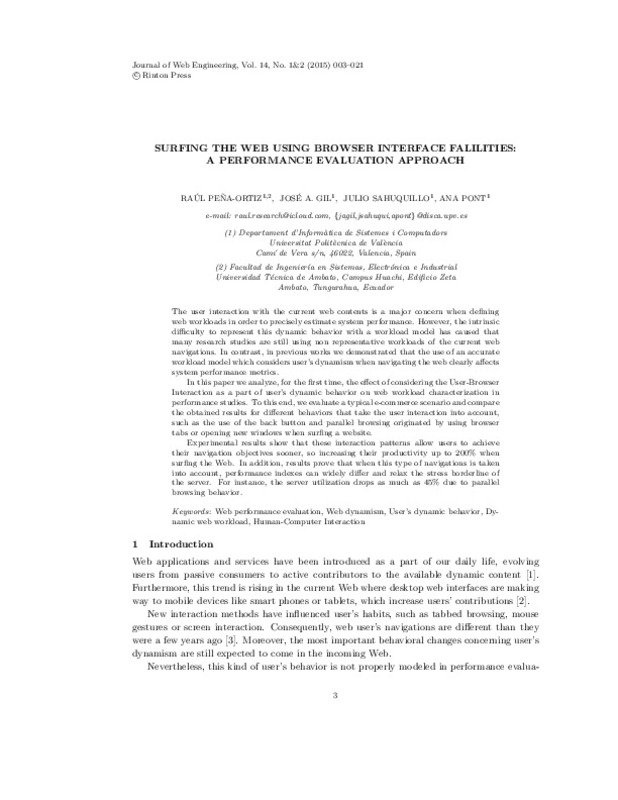JavaScript is disabled for your browser. Some features of this site may not work without it.
Buscar en RiuNet
Listar
Mi cuenta
Estadísticas
Ayuda RiuNet
Admin. UPV
Surfing the web using browser interface facilities: a performance evaluation approach
Mostrar el registro sencillo del ítem
Ficheros en el ítem
| dc.contributor.author | Peña Ortiz, Raúl
|
es_ES |
| dc.contributor.author | Gil Salinas, José Antonio
|
es_ES |
| dc.contributor.author | Sahuquillo Borrás, Julio
|
es_ES |
| dc.contributor.author | Pont Sanjuan, Ana
|
es_ES |
| dc.date.accessioned | 2016-05-10T08:44:34Z | |
| dc.date.available | 2016-05-10T08:44:34Z | |
| dc.date.issued | 2015-03 | |
| dc.identifier.issn | 1540-9589 | |
| dc.identifier.uri | http://hdl.handle.net/10251/63834 | |
| dc.description.abstract | [EN] The user interaction with the current web contents is a major concern when defining web workloads in order to precisely estimate system performance. However, the intrinsic difficulty to represent this dynamic behavior with a workload model has caused that many research studies are still using non representative workloads of the current web navigations. In contrast, in previous works we demonstrated that the use of an accurate workload model which considers user s dynamism when navigating the web clearly affects system performance metrics. In this paper we analyze, for the first time, the effect of considering the User-Browser Interaction as a part of user s dynamic behavior on web workload characterization in performance studies. To this end, we evaluate a typical e-commerce scenario and compare the obtained results for different behaviors that take the user interaction into account, such as the use of the back button and parallel browsing originated by using browser tabs or opening new windows when surfing a website. Experimental results show that these interaction patterns allow users to achieve their navigation objectives sooner, so increasing their productivity up to 200% when surfing the Web. In addition, results prove that when this type of navigations is taken into account, performance indexes can widely differ and relax the stress borderline of the server. For instance, the server utilization drops as much as 45% due to parallel browsing behavior. | es_ES |
| dc.description.sponsorship | This work has been partially supported by the Spanish Ministry Economy and Competitiveness under grant TIN-2013-43913-R. | |
| dc.language | Inglés | es_ES |
| dc.publisher | Rinton Press | es_ES |
| dc.relation.ispartof | Journal of Web Engineering | es_ES |
| dc.rights | Reserva de todos los derechos | es_ES |
| dc.subject | Web performance evaluation | es_ES |
| dc.subject | Web dynamism | es_ES |
| dc.subject | User’s dynamic behavior | es_ES |
| dc.subject | Dynamic web workload | es_ES |
| dc.subject | Human-Computer Interaction | es_ES |
| dc.subject.classification | ARQUITECTURA Y TECNOLOGIA DE COMPUTADORES | es_ES |
| dc.title | Surfing the web using browser interface facilities: a performance evaluation approach | es_ES |
| dc.type | Artículo | es_ES |
| dc.relation.projectID | info:eu-repo/grantAgreement/MINECO//TIN2013-43913-R/ES/EFICIENCIA ECONOMICA EN LA PLANIFICACION Y USO DE INFRAESTRUCTURAS CLOUD/ | es_ES |
| dc.rights.accessRights | Abierto | es_ES |
| dc.contributor.affiliation | Universitat Politècnica de València. Departamento de Informática de Sistemas y Computadores - Departament d'Informàtica de Sistemes i Computadors | es_ES |
| dc.description.bibliographicCitation | Peña Ortiz, R.; Gil Salinas, JA.; Sahuquillo Borrás, J.; Pont Sanjuan, A. (2015). Surfing the web using browser interface facilities: a performance evaluation approach. Journal of Web Engineering. 14(1-2):3-21. http://hdl.handle.net/10251/63834 | es_ES |
| dc.description.accrualMethod | S | es_ES |
| dc.relation.publisherversion | http://www.rintonpress.com/journals/jweonline.html#v14n12 | es_ES |
| dc.description.upvformatpinicio | 3 | es_ES |
| dc.description.upvformatpfin | 21 | es_ES |
| dc.type.version | info:eu-repo/semantics/publishedVersion | es_ES |
| dc.description.volume | 14 | es_ES |
| dc.description.issue | 1-2 | es_ES |
| dc.relation.senia | 284271 | es_ES |
| dc.contributor.funder | Ministerio de Economía y Competitividad |






